Constraint Mechanism of Power Device Design Based on Perovskite Quantum Dots Pumped by an Electron Beam
Abstract
:1. Introduction
2. Materials and Methods
2.1. CsPbBr3 Solution Preparation and Luminescence Film Characterization
2.2. Measurement Methods of Space–Time Coherence for Self-Saturation Luminescence Experiment
2.3. Measurement Methods of CsPbBr3 Self-Saturation Luminescence
2.4. Measurement Methods of CsPbBr3 Luminescence Aging Failure
3. Results and Discussion
3.1. CsPbBr3 self-Saturation Luminescence and Aging Failure Experimental Results
3.2. Discussion and Analysis
4. Conclusions
Author Contributions
Funding
Institutional Review Board Statement
Informed Consent Statement
Data Availability Statement
Conflicts of Interest
References
- Eaton, S.W.; Lai, M.; Gibson, N.A.; Wong, A.B.; Dou, L.; Ma, J.; Wang, L.-W.; Leone, S.R.; Yang, P. Lasing in robust cesium lead halide perovskite nanowires. Proc. Natl. Acad. Sci. USA 2016, 113, 1993–1998. [Google Scholar] [CrossRef] [PubMed] [Green Version]
- Wang, Y.; Li, X.; Zhao, X.; Xiao, L.; Zeng, H.; Sun, H. Nonlinear absorption and low-threshold multiphoton pumped stimulated emission from all-inorganic perovskite nanocrystals. Nano Lett. 2016, 16, 448–453. [Google Scholar] [CrossRef] [PubMed]
- Xu, Y.; Lou, S.; Xia, C.; Xuan, T.; Li, H. Controllable synthesis of all inorganic lead halide perovskite nanocrystals and white light-emitting diodes based on CsPbBr3 nanocrystals. J. Lumin. 2020, 222, 117132. [Google Scholar] [CrossRef]
- Yang, D.; Cao, M.; Zhong, Q.; Li, P.; Zhang, X.; Zhang, Q. All-inorganic cesium lead halide perovskite nanocrystals: Synthesis, surface engineering and applications. J. Mater. Chem. C 2019, 7, 757–789. [Google Scholar] [CrossRef]
- Chen, D.; Li, J.; Chen, X.; Chen, J.; Zhong, J. Grinding Synthesis of APbX3 (A = MA, FA, Cs; X = Cl, Br, I) Perovskite Nanocrystals. ACS Appl. Mater. Interfaces 2019, 11, 10059–10067. [Google Scholar] [CrossRef] [PubMed]
- Lin, J.; Yang, C.; Huang, P.; Wang, S.; Liu, M.; Jiang, N.; Chen, D. Photoluminescence tuning from glass-stabilized CsPbX3 (X = Cl, Br, I) perovskite nanocrystals triggered by upconverting Tm: KYb2F7 nanoparticles for high-level anti-counterfeiting. Chem. Eng. J. 2020, 395, 125214. [Google Scholar] [CrossRef]
- Wang, Y.; Zhang, R.; Yue, Y.; Yan, S.; Zhang, L.; Chen, D. Room temperature synthesis of CsPbX3 (X= Cl, Br, I) perovskite quantum dots by water-induced surface crystallization of glass. J. Alloy. Compd. 2020, 818, 152872. [Google Scholar] [CrossRef]
- Shen, Z.; Zhao, S.; Song, D.; Xu, Z.; Qiao, B.; Song, P.; Bai, Q.; Cao, J.; Zhang, G.; Swelm, W. Improving the Quality and Luminescence Performance of All-Inorganic Perovskite Nanomaterials for Light-Emitting Devices by Surface Engineering. Small 2020, 16, 1907089. [Google Scholar] [CrossRef]
- Ye, F.; Zhang, H.; Wang, P.; Cai, J.; Wang, L.; Liu, D.; Wang, T. Spectral Tuning of Efficient CsPbBrxCl3–x Blue Light-Emitting Diodes via Halogen Exchange Triggered by Benzenesulfonates. Chem. Mater. 2020, 32, 3211–3218. [Google Scholar] [CrossRef]
- Kovalenko, M.V.; Protesescu, L.; Bodnarchuk, M.I. Properties and potential optoelectronic applications of lead halide perovskite nanocrystals. Science 2017, 358, 745–750. [Google Scholar] [CrossRef] [Green Version]
- Nedelcu, G.; Protesescu, L.; Yakunin, S.; Bodnarchuk, M.I.; Grotevent, M.J.; Kovalenko, M.V. Fast anion-exchange in highly luminescent nanocrystals of cesium lead halide perovskites (CsPbX3, X = Cl, Br, I). Nano Lett. 2015, 15, 5635–5640. [Google Scholar] [CrossRef] [PubMed]
- Bailey, R.E.; Nie, S. Alloyed semiconductor quantum dots: Tuning the optical properties without changing the particle size. J. Am. Chem. Soc. 2003, 125, 7100–7106. [Google Scholar] [CrossRef] [PubMed]
- Tan, Y.; Zou, Y.; Wu, L.; Huang, Q.; Yang, D.; Chen, M.; Ban, M.; Wu, C.; Wu, T.; Bai, S. Highly luminescent and stable perovskite nanocrystals with octylphosphonic acid as a ligand for efficient light-emitting diodes. ACS Appl. Mater. Interfaces 2018, 10, 3784–3792. [Google Scholar] [CrossRef] [PubMed]
- Liu, A.; Bi, C.; Guo, R.; Zhang, M.; Qu, X.; Tian, J. Electroluminescence Principle and Performance Improvement of Metal Halide Perovskite Light-Emitting Diodes. Adv. Opt. Mater. 2021, 9, 2002167. [Google Scholar] [CrossRef]
- Lin, K.; Xing, J.; Quan, L.N.; De Arquer, F.; Gong, X.; Lu, J.; Xie, L.; Zhao, W.; Zhang, D.; Yan, C. Perovskite light-emitting diodes with external quantum efficiency exceeding 20 per cent. Nature 2018, 562, 245–248. [Google Scholar] [CrossRef] [PubMed]
- Bera, S.; Pradhan, N. Perovskite nanocrystal heterostructures: Synthesis, optical properties, and applications. ACS Energy Lett. 2020, 5, 2858–2872. [Google Scholar] [CrossRef]
- Nette, J.; Howes, P.D.; deMello, A.J. Microfluidic Synthesis of Luminescent and Plasmonic Nanoparticles: Fast, Efficient, and Data-Rich. Adv. Mater. Technol. 2020, 5, 2000060. [Google Scholar] [CrossRef]
- Ren, A.; Wang, H.; Zhang, W.; Wu, J.; Wang, Z.; Penty, R.V.; White, I.H. Emerging light-emitting diodes for next-generation data communications. Nat. Electron. 2021, 4, 559–572. [Google Scholar] [CrossRef]
- Zhang, Y.; Lim, C.-K.; Dai, Z.; Yu, G.; Haus, J.W.; Zhang, H.; Prasad, P.N. Photonics and optoelectronics using nano-structured hybrid perovskite media and their optical cavities. Phys. Rep. 2019, 795, 1–51. [Google Scholar] [CrossRef]
- Li, C.; Zang, Z.; Han, C.; Hu, Z.; Tang, X.; Du, J.; Leng, Y.; Sun, K. Highly compact CsPbBr3 perovskite thin films decorated by ZnO nanoparticles for enhanced random lasing. Nano Energy 2017, 40, 195–202. [Google Scholar] [CrossRef]
- Wang, Y.-C.; Li, H.; Hong, Y.-H.; Hong, K.-B.; Chen, F.-C.; Hsu, C.-H.; Lee, R.-K.; Conti, C.; Kao, T.S.; Lu, T.-C. Flexible organometal–halide perovskite lasers for speckle reduction in imaging projection. ACS Nano 2019, 13, 5421–5429. [Google Scholar] [CrossRef] [PubMed]
- Wang, X.; Zhou, H.; Yuan, S.; Zheng, W.; Jiang, Y.; Zhuang, X.; Liu, H.; Zhang, Q.; Zhu, X.; Wang, X. Cesium lead halide perovskite triangular nanorods as high-gain medium and effective cavities for multiphoton-pumped lasing. Nano Res. 2017, 10, 3385–3395. [Google Scholar] [CrossRef]
- Yan, D.; Shi, T.; Zang, Z.; Zhao, S.; Du, J.; Leng, Y. Stable and low-threshold whispering-gallery-mode lasing from modified CsPbBr3 perovskite quantum dots@SiO2 sphere. Chem. Eng. J. 2020, 401, 126066. [Google Scholar] [CrossRef]
- Sun, X.; Gao, Z.; Zhang, W.; Liu, Y.; Xu, B.; Wang, Z.; Wang, X.; Meng, X. Lasing from solution-processed CsPbBr3 octahedral resonators. J. Lumin. 2021, 229, 117713. [Google Scholar] [CrossRef]
- Wang, K.; Wang, S.; Xiao, S.; Song, Q. Recent advances in perovskite micro-and nanolasers. Adv. Opt. Mater. 2018, 6, 1800278. [Google Scholar] [CrossRef]
- Li, F.; Jiang, M.; Cheng, Y.; Zhang, Y.; Yang, Z.; Peng, Y.; Ma, W.; Chen, Q.; Wang, C.; Liu, K. Single-mode lasing of CsPbBr3 perovskite NWs enabled by the Vernier effect. Nanoscale 2021, 13, 4432–4438. [Google Scholar] [CrossRef]
- Yang, Z.; Lu, J.; ZhuGe, M.; Cheng, Y.; Hu, J.; Li, F.; Qiao, S.; Zhang, Y.; Hu, G.; Yang, Q. Controllable growth of aligned monocrystalline CsPbBr3 microwire arrays for piezoelectric-induced dynamic modulation of single-mode lasing. Adv. Mater. 2019, 31, 1900647. [Google Scholar] [CrossRef]
- Hong, Y.-H.; Kao, T.S. Room-temperature random lasing of metal-halide perovskites via morphology-controlled synthesis. Nanoscale Adv. 2020, 2, 5833–5840. [Google Scholar] [CrossRef]
- Kao, T.S.; Hong, Y.-H.; Hong, K.-B.; Lu, T.-C. Perovskite random lasers: A tunable coherent light source for emerging applications. Nanotechnology 2021, 32, 28. [Google Scholar] [CrossRef]
- Lv, W.; Li, L.; Xu, M.; Hong, J.; Tang, X.; Xu, L.; Wu, Y.; Zhu, R.; Chen, R.; Huang, W. Improving the stability of metal halide perovskite quantum dots by encapsulation. Adv. Mater. 2019, 31, 1900682. [Google Scholar] [CrossRef]
- Wu, X.; Jiang, X.-F.; Hu, X.; Zhang, D.-F.; Li, S.; Yao, X.; Liu, W.; Yip, H.-L.; Tang, Z.; Xu, Q.-H. Highly stable enhanced near-infrared amplified spontaneous emission in solution-processed perovskite films by employing polymer and gold nanorods. Nanoscale 2019, 11, 1959–1967. [Google Scholar] [CrossRef] [PubMed]
- Pushkarev, A.P.; Korolev, V.I.; Markina, D.I.; Komissarenko, F.E.; Naujokaitis, A.; Drabavicius, A.; Pakstas, V.; Franckevicius, M.; Khubezhov, S.A.; Sannikov, D.A. A few-minute synthesis of CsPbBr3 nanolasers with a high quality factor by spraying at ambient conditions. ACS Appl. Mater. Interfaces 2018, 11, 1040–1048. [Google Scholar] [CrossRef] [PubMed]
- Qaid, S.M.; Alharbi, F.H.; Bedja, I.; Nazeeruddin, M.K.; Aldwayyan, A.S. Reducing amplified spontaneous emission threshold in CsPbBr3 quantum dot films by controlling TiO2 compact layer. Nanomaterials 2020, 10, 1605. [Google Scholar] [CrossRef] [PubMed]
- Qaid, S.M.; Ghaithan, H.M.; Al-Asbahi, B.A.; Alqasem, A.; Aldwayyan, A.S. Fabrication of thin films from powdered cesium lead bromide (CsPbBr3) perovskite quantum dots for coherent green light emission. ACS Omega 2020, 5, 30111–30122. [Google Scholar] [CrossRef] [PubMed]
- Wu, C.-S.; Wu, S.-C.; Yang, B.-T.; Wu, Z.Y.; Chou, Y.H.; Chen, P.; Hsu, H.-C. Hemispherical Cesium Lead Bromide Perovskite Single-Mode Microlasers with High-Quality Factors and Strong Purcell Enhancement. ACS Appl. Mater. Interfaces 2021, 13, 13556–13564. [Google Scholar] [CrossRef] [PubMed]
- Zhong, Y.; Liao, K.; Du, W.; Zhu, J.; Shang, Q.; Zhou, F.; Wu, X.; Sui, X.; Shi, J.; Yue, S. Large-scale thin CsPbBr3 single-crystal film grown on sapphire via chemical vapor deposition: Toward laser array application. ACS Nano 2020, 14, 15605–15615. [Google Scholar] [CrossRef]
- Fan, H.; Mu, Y.; Liu, C.; Zhu, Y.; Liu, G.; Wang, S.; Li, Y.; Du, P. Random lasing of CsPbBr 3 perovskite thin films pumped by modulated electron beam. Chin. Opt. Lett. 2020, 18, 011403. [Google Scholar] [CrossRef]
- Peng, D.; Yi-ning, M.; Hang, R.; Hai-bo, F.; Yan, Z.; Yan-zheng, L.; Monroy, I. Transient luminescence characteristics of random laser emission based on electron beam pumping perovskite nanocrystals. Acta Photonica Sin. 2020, 49, 0404001. [Google Scholar] [CrossRef]
- Li, Q.; Lian, T. Ultrafast charge separation in two-dimensional CsPbBr3 perovskite nanoplatelets. J. Phys. Chem. Lett. 2019, 10, 566–573. [Google Scholar] [CrossRef]
- Zhu, H.; Miyata, K.; Fu, Y.; Wang, J.; Joshi, P.P.; Niesner, D.; Williams, K.W.; Jin, S.; Zhu, X.-Y. Screening in crystalline liquids protects energetic carriers in hybrid perovskites. Science 2016, 353, 1409–1413. [Google Scholar] [CrossRef] [Green Version]
- Hussain, M.; Rashid, M.; Saeed, F.; Bhatti, A. Spin–orbit coupling effect on energy level splitting and band structure inversion in CsPbBr3. J. Mater. Sci. 2021, 56, 528–542. [Google Scholar] [CrossRef]
- Cinquanta, E.; Meggiolaro, D.; Motti, S.G.; Gandini, M.; Alcocer, M.J.; Akkerman, Q.A.; Vozzi, C.; Manna, L.; De Angelis, F.; Petrozza, A. Ultrafast THz probe of photoinduced polarons in lead-halide perovskites. Phys. Rev. Lett. 2019, 122, 166601. [Google Scholar] [CrossRef] [PubMed] [Green Version]
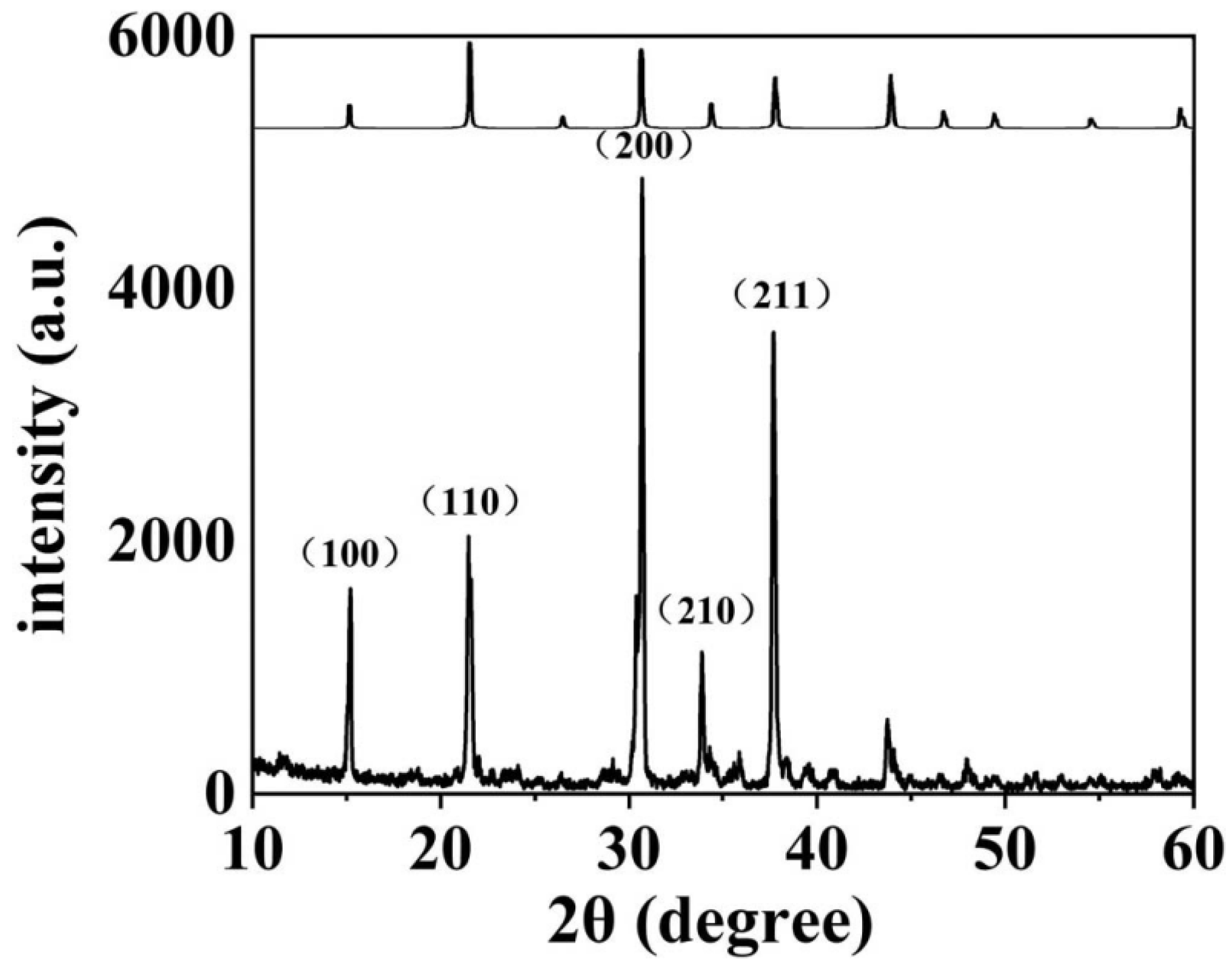

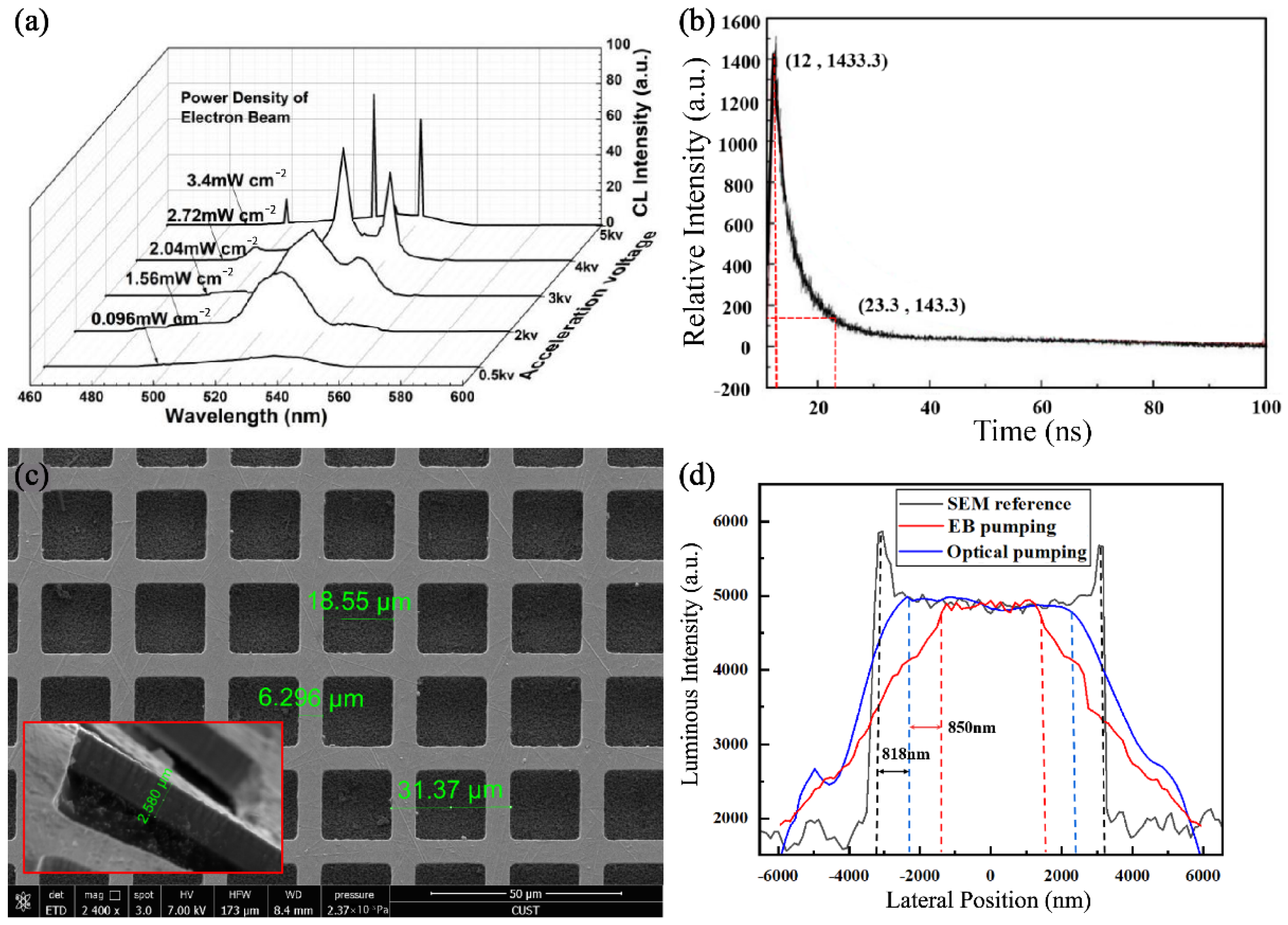

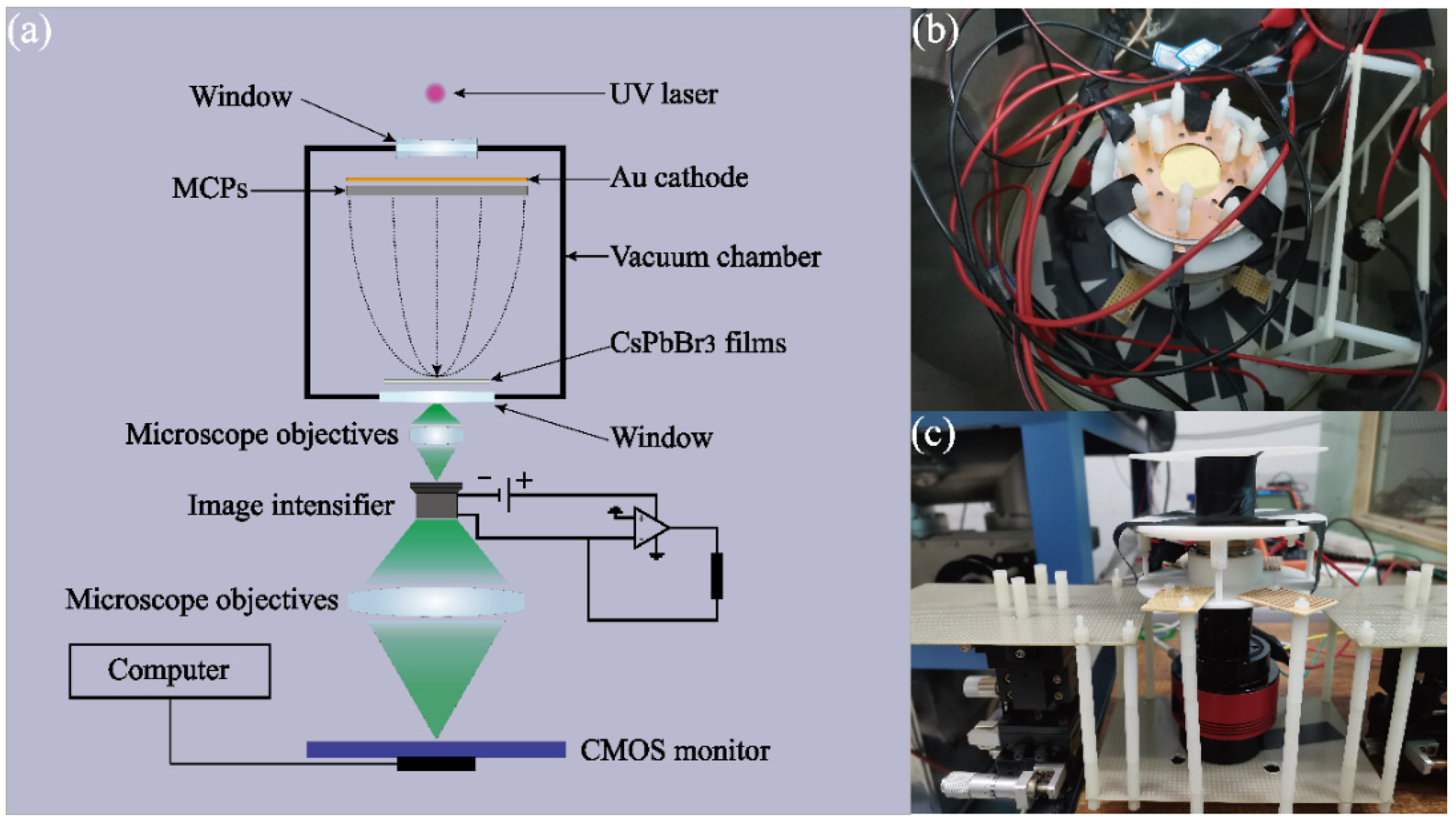
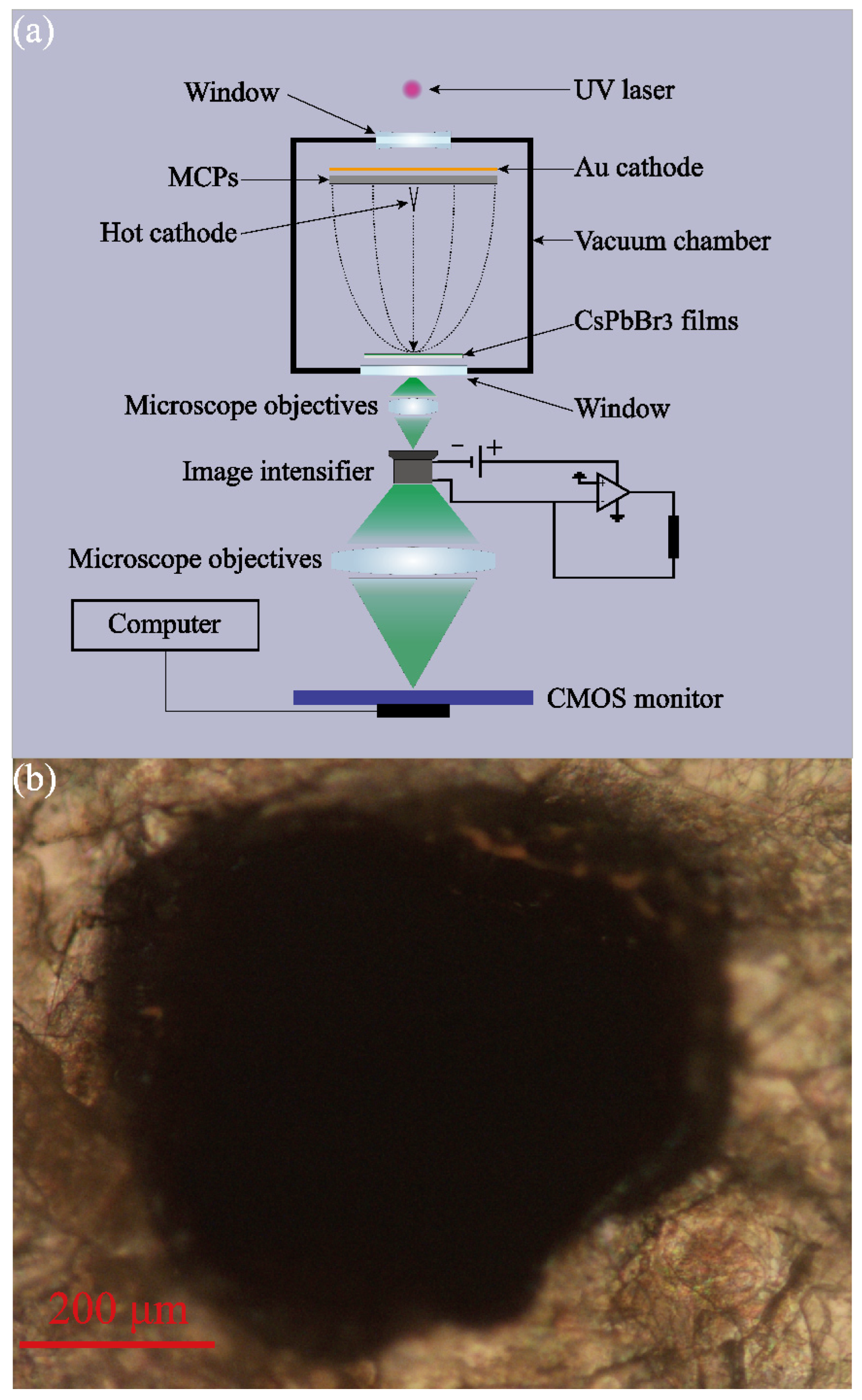
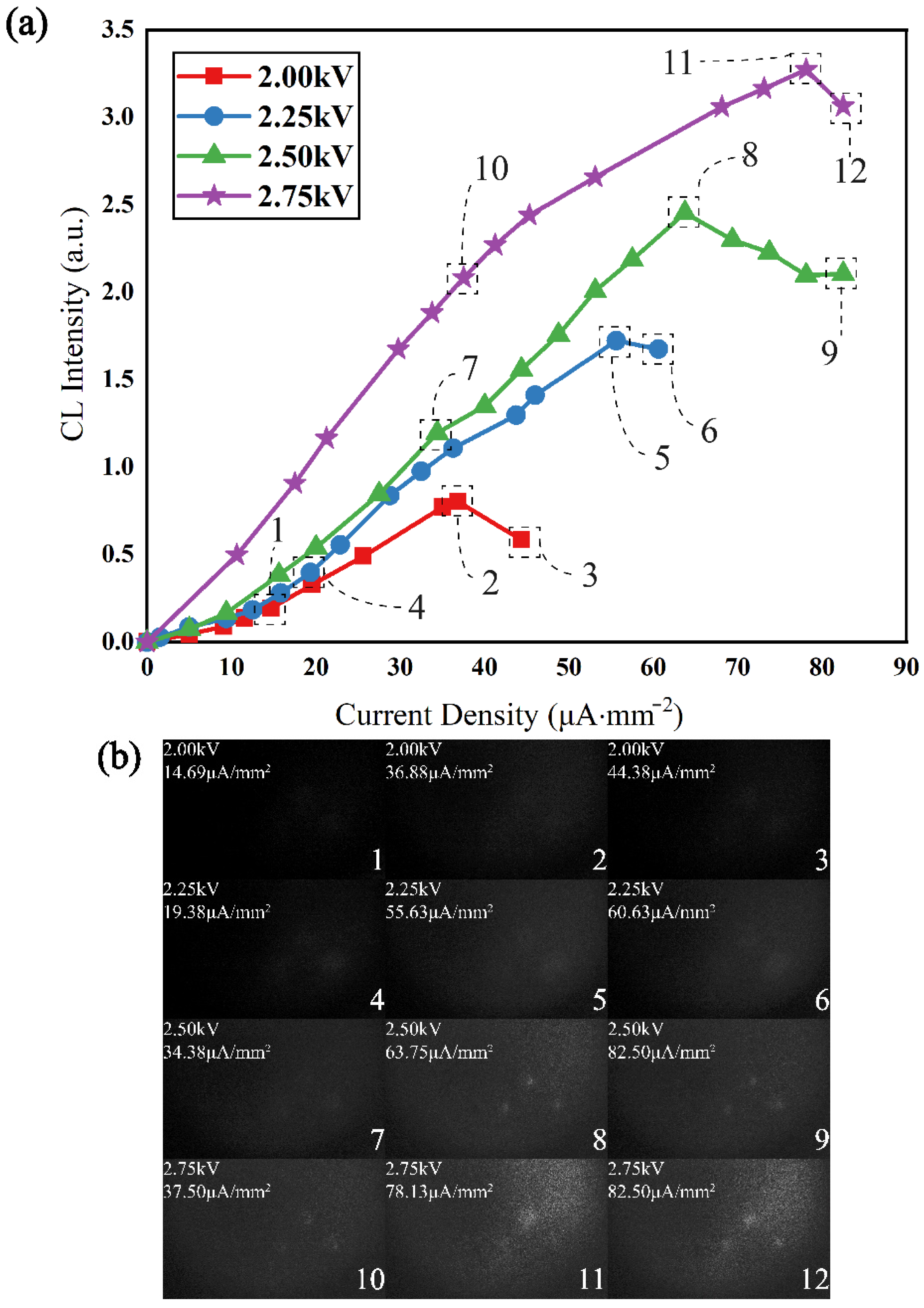
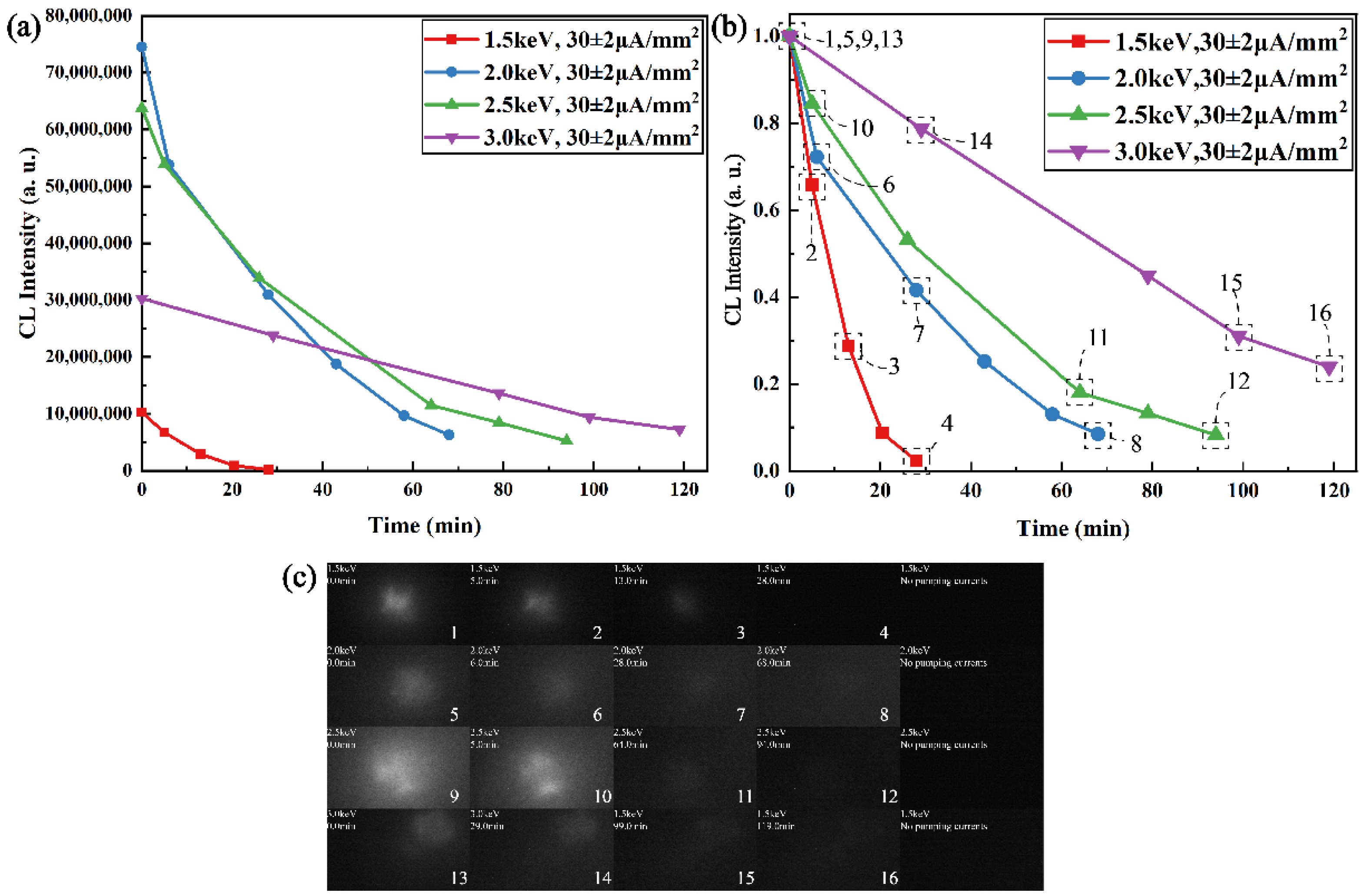

Publisher’s Note: MDPI stays neutral with regard to jurisdictional claims in published maps and institutional affiliations. |
© 2022 by the authors. Licensee MDPI, Basel, Switzerland. This article is an open access article distributed under the terms and conditions of the Creative Commons Attribution (CC BY) license (https://creativecommons.org/licenses/by/4.0/).
Share and Cite
Mu, Y.; Li, Y.; Du, P.; Ren, H.; Monroy, I.T.; Ibrahim, M.; Wen, G.; Liang, D.; Feng, J.; Ao, J.; et al. Constraint Mechanism of Power Device Design Based on Perovskite Quantum Dots Pumped by an Electron Beam. Sensors 2022, 22, 3721. https://doi.org/10.3390/s22103721
Mu Y, Li Y, Du P, Ren H, Monroy IT, Ibrahim M, Wen G, Liang D, Feng J, Ao J, et al. Constraint Mechanism of Power Device Design Based on Perovskite Quantum Dots Pumped by an Electron Beam. Sensors. 2022; 22(10):3721. https://doi.org/10.3390/s22103721
Chicago/Turabian StyleMu, Yining, Yanzheng Li, Peng Du, Hang Ren, Idelfonso Tafur Monroy, Makram Ibrahim, Guanyu Wen, Dong Liang, Jianshang Feng, Jiayu Ao, and et al. 2022. "Constraint Mechanism of Power Device Design Based on Perovskite Quantum Dots Pumped by an Electron Beam" Sensors 22, no. 10: 3721. https://doi.org/10.3390/s22103721






